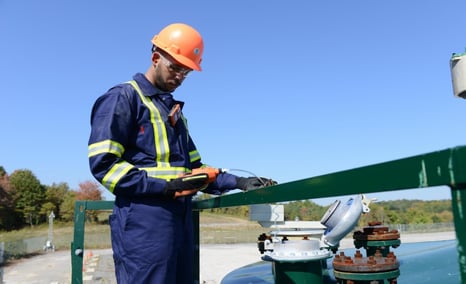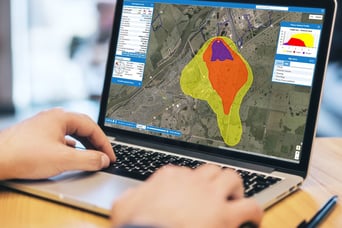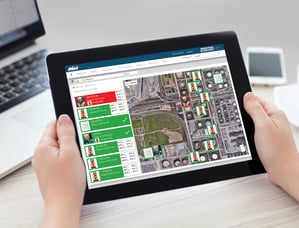When it comes to safety in industrial environments, real-time connectivity through connected safety solutions is key.
Safety managers have seen how new technologies, tools, and strategies can reduce downtime and boost operational efficiencies, and it shows in recent market growth. As of 2021, the global market for connected worker solutions was worth $1.35 billion and according to Verdantix, is expected to reach $3.0 billion by 2026.
Of course, linking a workforce through connected safety tools like live monitoring, peer-to-peer sharing, and professional safety monitoring won’t eliminate gas hazards. Rather, connected safety can be used to better monitor gas hazards on a facility-wide scale so both workers and safety managers can make informed decisions.
Although using connected safety technology to connect teams has huge advantages, the concept may still feel overwhelming for some. Wireless gas detectors are a great starting point because they incorporate connectivity into safety equipment your workers already use.
If you’re looking to improve safety in your facility, review the benefits of using gas detectors to connect your workforce.
What is a Connected Workforce?
 A connected workforce is one in which workers use devices that collect and securely share information about the worker’s environment. Information like gas readings or panic alarms can be shared with peers nearby through a simple and reliable mesh network, as well as with safety contacts off-site through cloud-based live monitoring programs. This connectivity ultimately allows both workers and safety managers to make decisions that improve safety on the job.
A connected workforce is one in which workers use devices that collect and securely share information about the worker’s environment. Information like gas readings or panic alarms can be shared with peers nearby through a simple and reliable mesh network, as well as with safety contacts off-site through cloud-based live monitoring programs. This connectivity ultimately allows both workers and safety managers to make decisions that improve safety on the job.
Connectivity also makes it possible for lone workers or workers on the job around the clock to automatically share their status and work environment conditions to call agents who can monitor their safety when worksite leaders aren’t able to respond—through connectivity, workers can be confident that they’ll get the help they need, quickly, if the situation arises.
Advantages of a Connected Workforce
Various technological advances have helped to reduce worker injuries over time, but connecting workers offers a more sophisticated system for ensuring safety. There are five distinct areas where connecting your workforce can make a difference for you:
1. Inform Your Workers
In industrial environments, emergencies will happen—and when they do, every second matters. Peer-to-peer connected devices ensure that those in danger can rely on other workers nearby for help. Rather than guessing what to do when a gas monitor goes into alarm, peers get the information they need to act fast without putting themselves in danger, too. Whether a gas hazard, man-down, or panic situation causes an instrument to alarm, all peers in the connected group will instantly know who is in danger and why. This leads to better safety outcomes for individual workers, the team, and the organization.
2. Get the Data You Need
Connecting your workforce allows you to aggregate gas detection data to identify high-priority maintenance or repairs, recognize trends, and reduce overall risk. All of these data points make it much easier to make informed decisions that help you boost the effectiveness of your program.
For example, repeated low-level gas exposures in a certain location on your site can help you discover and resolve problem areas before they impact worker safety. For example, visual summaries of gas alarms make it easy to identify and fix a low-level gas leak that you otherwise might not have noticed until concentrations reached alarm-threshold levels. Over time, continuously using these data points to address problem areas will improve the efficacy of your safety program.
3. Receive Instant Updates
Real-time knowledge of each worker’s location and environment is essential in industrial environments, especially in the event of a gas release. Connected devices with live monitoring tools, like some personal multi-gas monitors and area monitors, can automatically alert safety contacts via text or email when a worker encounters a gas hazard, falls, or experiences any other emergency. At the same time, peer-to-peer mesh networks can alert workers nearby so they can take appropriate action. Both live monitoring and peer-to-peer connectivity take the burden of communication off the worker in danger. Alerts are shared automatically, allowing everyone to act quickly.
4. Rely on Professional Monitoring
You can’t always be available to respond to worker alarms like gas exposure and panic or man-down alerts when their hours are irregular or no one else is on site. A real-time response monitoring service like 24/7 Professional Monitoring can help cover gaps in your safety team without sacrificing the safety of your workers. Even if supervisors miss an alert or are inaccessible, your workers can have peace of mind knowing that agents will pursue help immediately.
When a worker's gas monitor detects dangerous conditions, a response center agent will immediately take action, following your custom response plan until they can confirm that the worker is safe and stakeholders are notified.
You can configure your escalation plan based on your company policy and alarm type to ensure that the proper follow-up occurs. With a call center team to back you up using automatic data sharing, you can be confident that incidents will be pursued until your team is safe.
5. Reduce Risk
With real-time information on safety challenges your workers face, you can follow up on incidents in minutes or count on an agent to escalate the situation until help arrives. When a situation arises, both you and your workers will have the information needed to react quickly and appropriately. After the fact, data gathered from the event offers insight into how you can improve your facility’s safety response in the future. On the whole, connecting your workforce allows you to use data and insights to make smarter safety decisions and ultimately reduce your facility’s operational risk and thus improve profitability.
Looking Forward
The world still needs to take significant strides when it comes to workplace safety. The International Labour Organization estimates that almost 375 million people are injured and 2.78 million people die each year from occupational illnesses or accidents.
Until we can eliminate the hazards workers face each day, connected safety technology is one way to improve emergency response times and give workers the real-time knowledge they need to make smarter, faster, safer decisions.



